This homemade lavender salve uses flower-infused oil from fresh or dried lavender flowers. Lavender is known for its calming scent, and some research suggests it may promote relaxation and improve sleep quality. It can also be used in topical applications to help moisturize the skin.
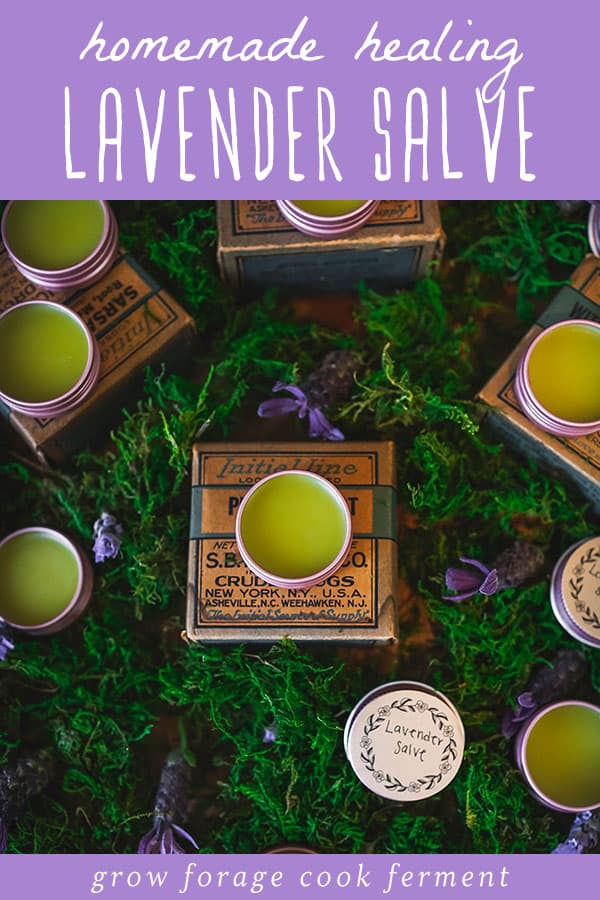
Want to save this post for later?
Lavender Benefits
Lavender has long been known for its pretty flowers and dreamy aromatics, and its popularity has come about for good reason. This herb is easy to grow and is also used in culinary dishes and herbal preparations.
Aromatherapy using lavender has been studied for its potential sleep-supporting effects, while topical lavender-infused salves are commonly used in skincare routines.
Using lavender-infused salves, with their pleasant scent and moisturizing properties, is a lovely way to incorporate lavender into your routine.
Some studies indicate that lavender aromatherapy may have mild sedative effects, helping with relaxation and sleep. I recommend using it at night to breathe in a relaxing smell while you drift off to sleep, and wake up with incredibly soft skin.
Lavender is a common ingredient in herbal skincare, highly valued for its aromatic properties and use in various cosmetic formulations. It can also make delicious desserts, drinks, and even edible herbal recipes like these popsicles.
This versatile flower has been studied for its potential antibacterial and anti-inflammatory properties, which may be beneficial for minor skin irritations. (Reactions can vary, so a patch test is recommended.)
Some research suggests that lavender oil may have properties that help with minor skin discomfort, but it should not be used as a substitute for medical treatment.
Lavender is a common backyard flower, and along with being an awesome pollinator plant, it also has wonderful healing and soothing medicinal properties. I’d grow a lavender forest if I could!
Related: 10 Reasons to Grow Lavender, and 10 Herbal Salve Recipes for Natural Skin Care
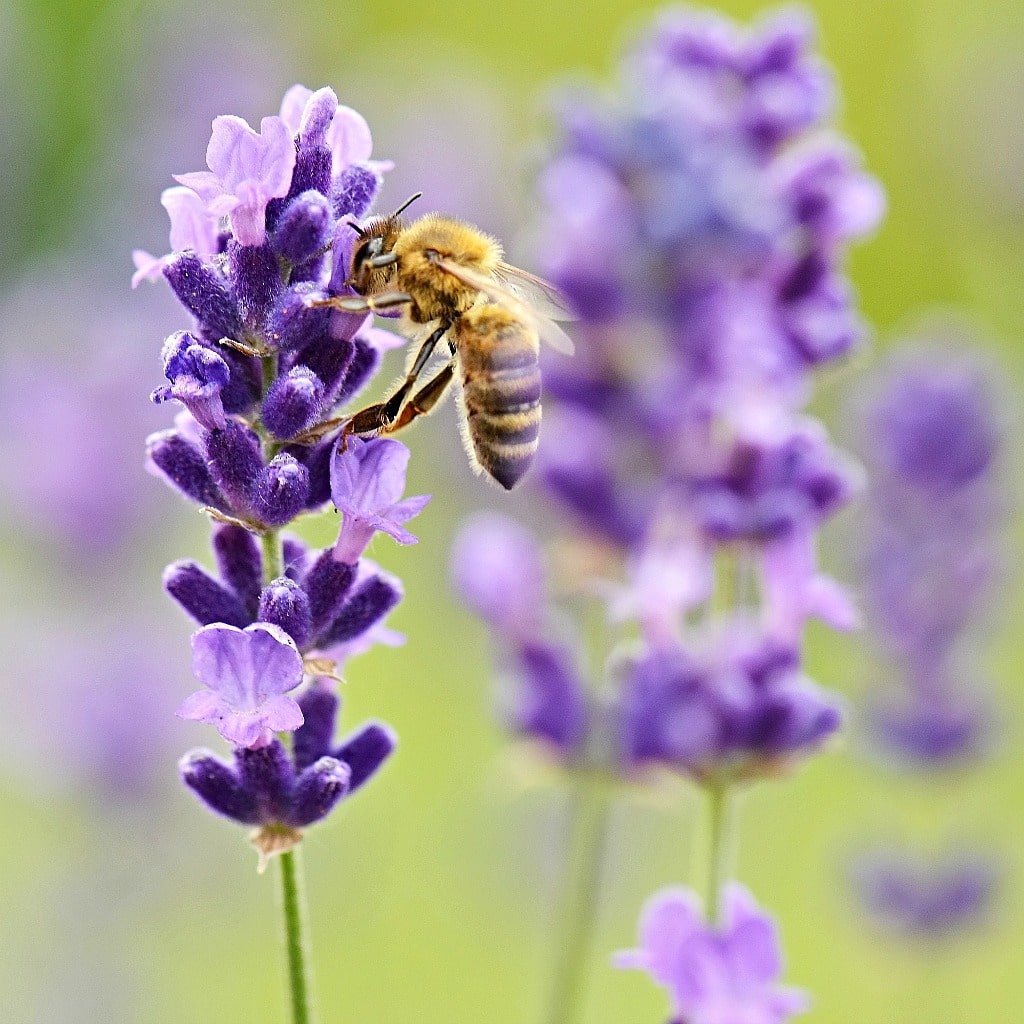
Lavender Salve for Skincare
With such wonderful properties for the skin, it’s no wonder lavender is popular in herbal skin care recipes and treatments too. Some of my favorites are this lavender lip balm and this homemade deodorant!
Another benefit of lavender is that it can repel bugs that you don’t want all up in your bubble. It will keep mosquitos, moths, and flies at bay, and also repel fleas and ticks. This salve is an asset to your health!
How to Make Healing Lavender Salve
Lavender salve is up to the task when you need it whether you need skincare or a peaceful mind. With a creamy and ultra-moisturizing consistency, this lavender recipe is stored in tins and is great for on-the-go!
Ingredients
Lavender flower buds – I used dried flowers, but if you have fresh growing lavender that works just as well!
Olive oil – I prefer organic extra virgin olive oil, but use what you have, any olive oil will do.
Coconut oil – This refined coconut oil is wonderful for skin care recipes.
Beeswax – Using beeswax in pastilles form makes it easy, but use what you have! If you prefer not to use beeswax, carnauba wax can often be used in salves as a substitute, but I haven’t tried that specifically in this recipe.
Shea butter – Refined shea butter will make an odorless and wonderful moisturizing addition to this herbal salve.
Lavender essential oil – The addition of lavender essential oil is optional and just depends on how strong of a lavender scent you want.
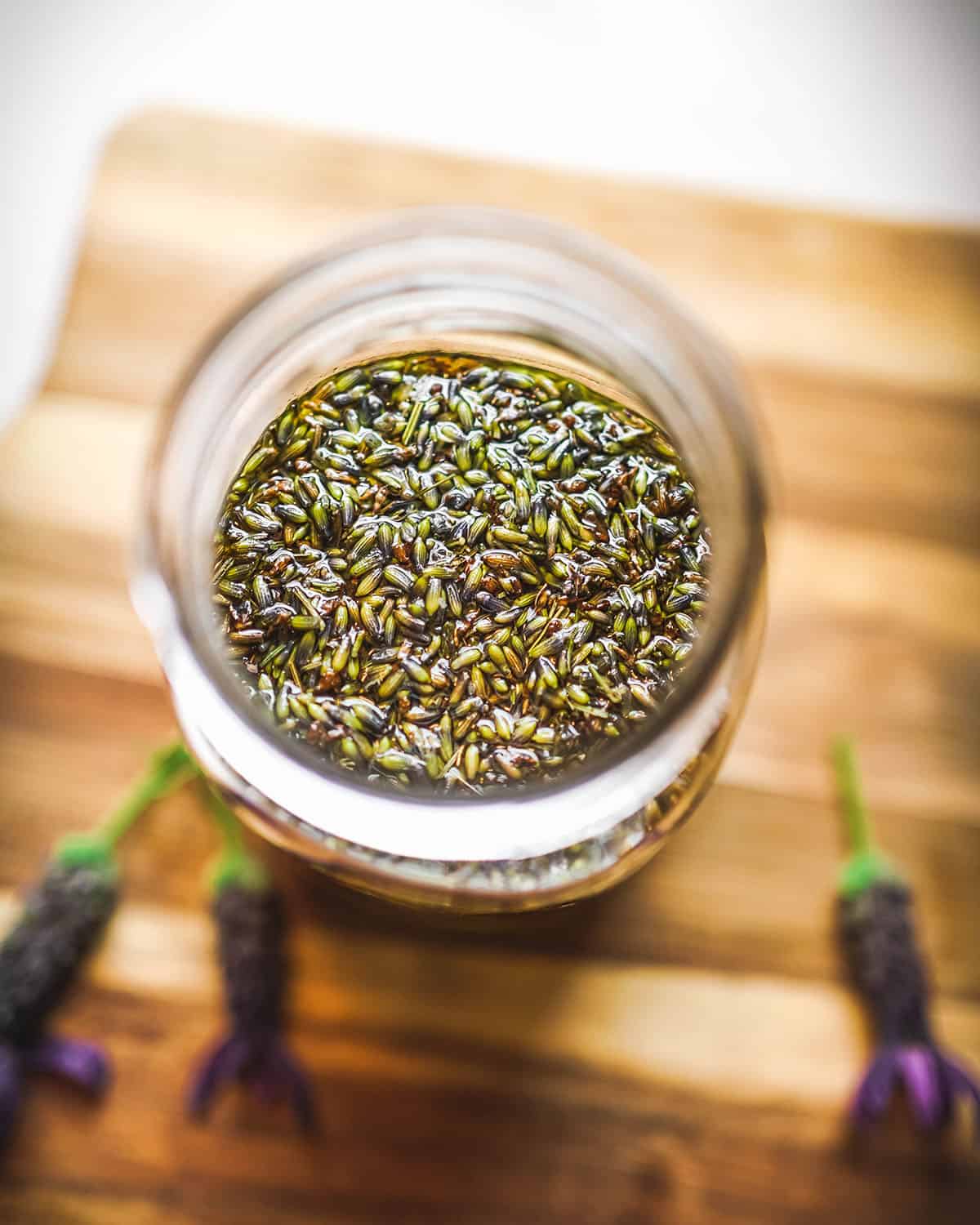
Make the Lavender Infused Oil
The first thing to do to create this lovely aromatic healing salve with lavender is to make lavender-infused oil to use as the base.
Put 1/2 cup of lavender buds in a pint jar, add olive oil over the flowers until the jar is 3/4 full, and top it off with coconut oil.
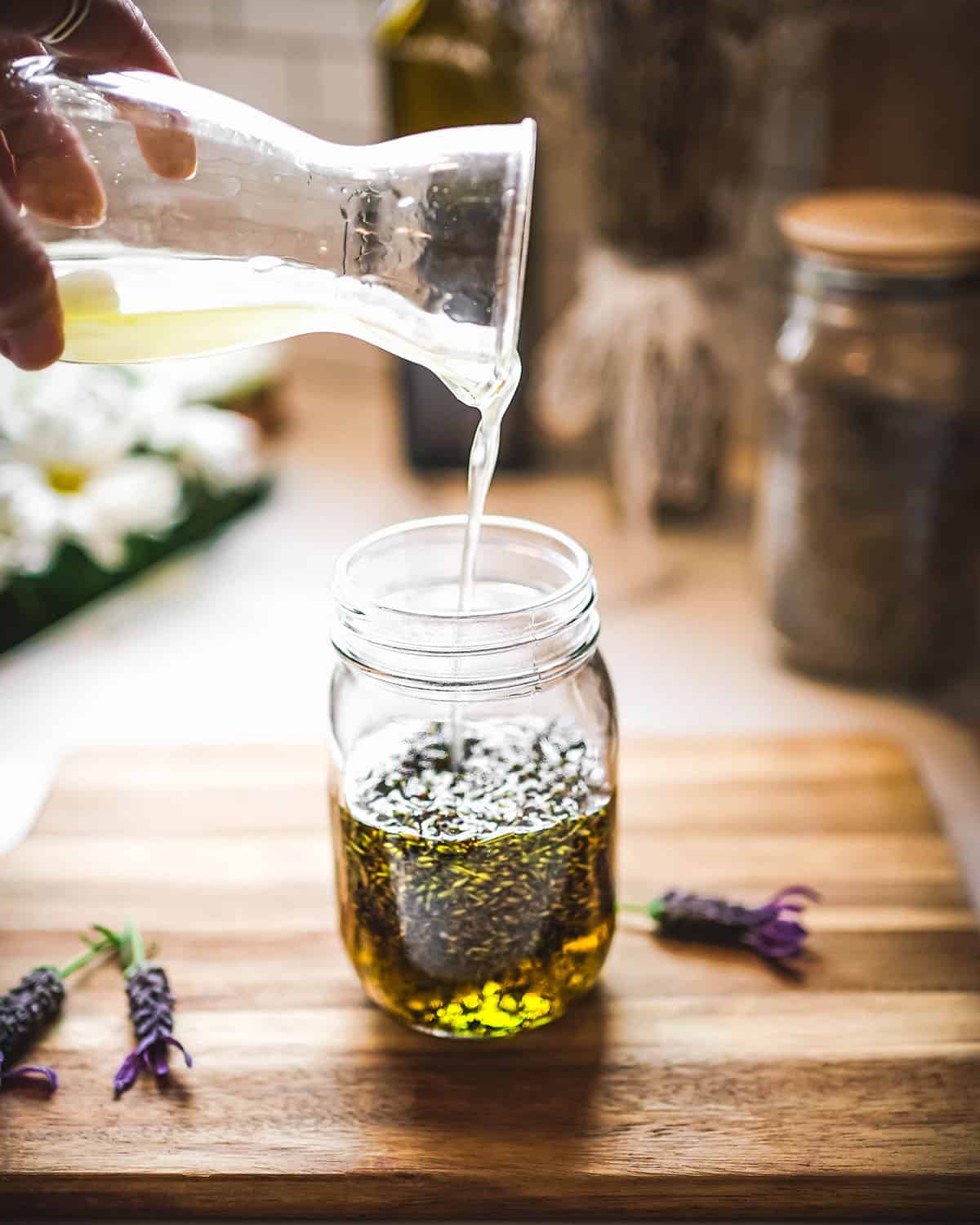
Place a lid or cap on the jar and gently shake it to incorporate the ingredients.
For a slower infusion, set the jar away from sunlight in a dry area and let it infuse for a few weeks.
For a quick infusion method, use a pot with water and place the jar with the lavender and oils in the pot. Allow the pot to simmer on low for several hours to slowly heat the flowers and oil in the jar.
Take the pot off of the heat and let the jar sit in the warm water bath for the rest of the day.
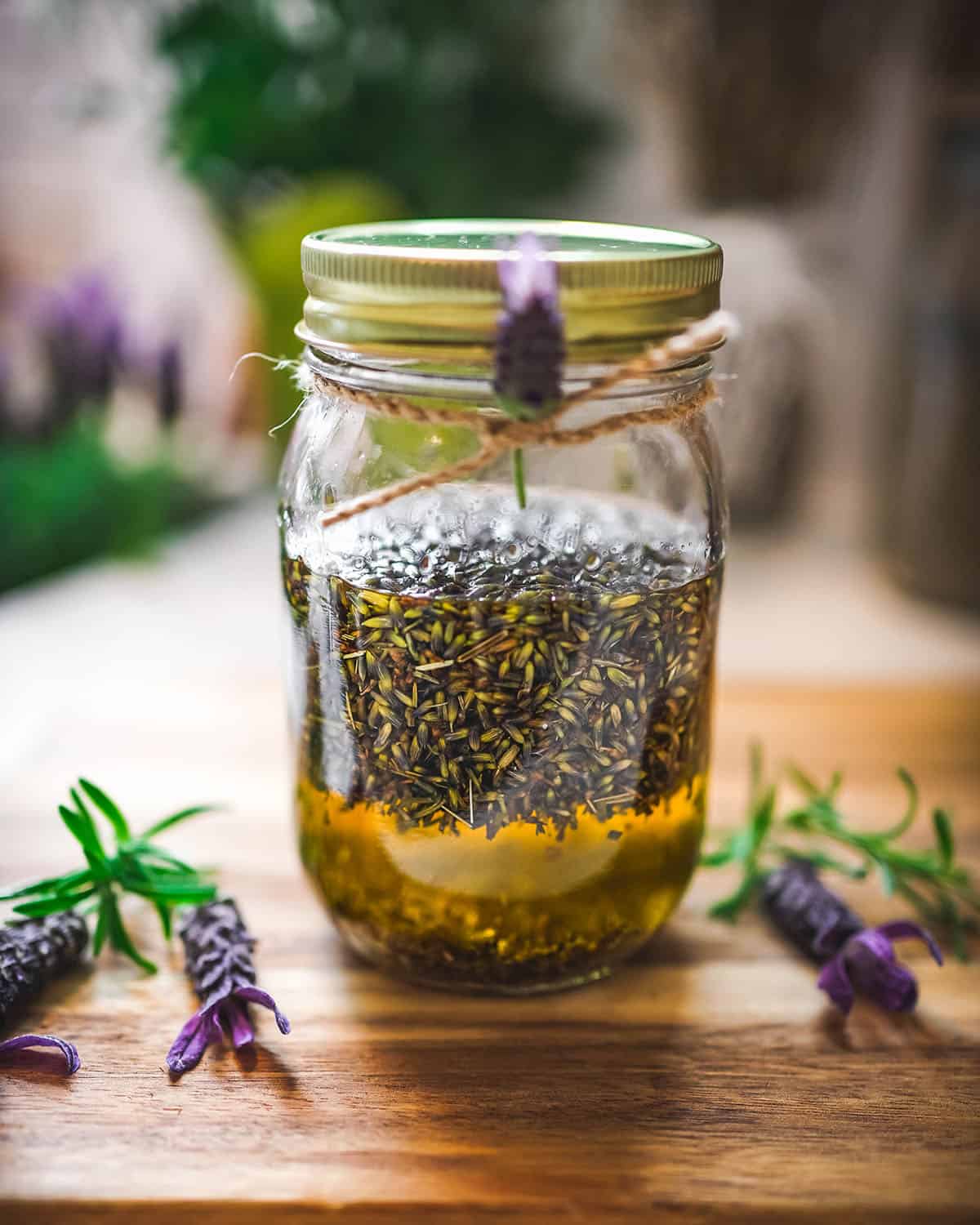
Strain the Oil
Once the lavender oil is infused it’s time to strain the flowers out.
Use a mesh strainer lined with cheesecloth and pour the oil into a measuring cup or a bowl.
I prefer a measuring cup because that way I can make sure I’m only straining the amount I need. Any leftovers can continue to infuse and use for other recipes.
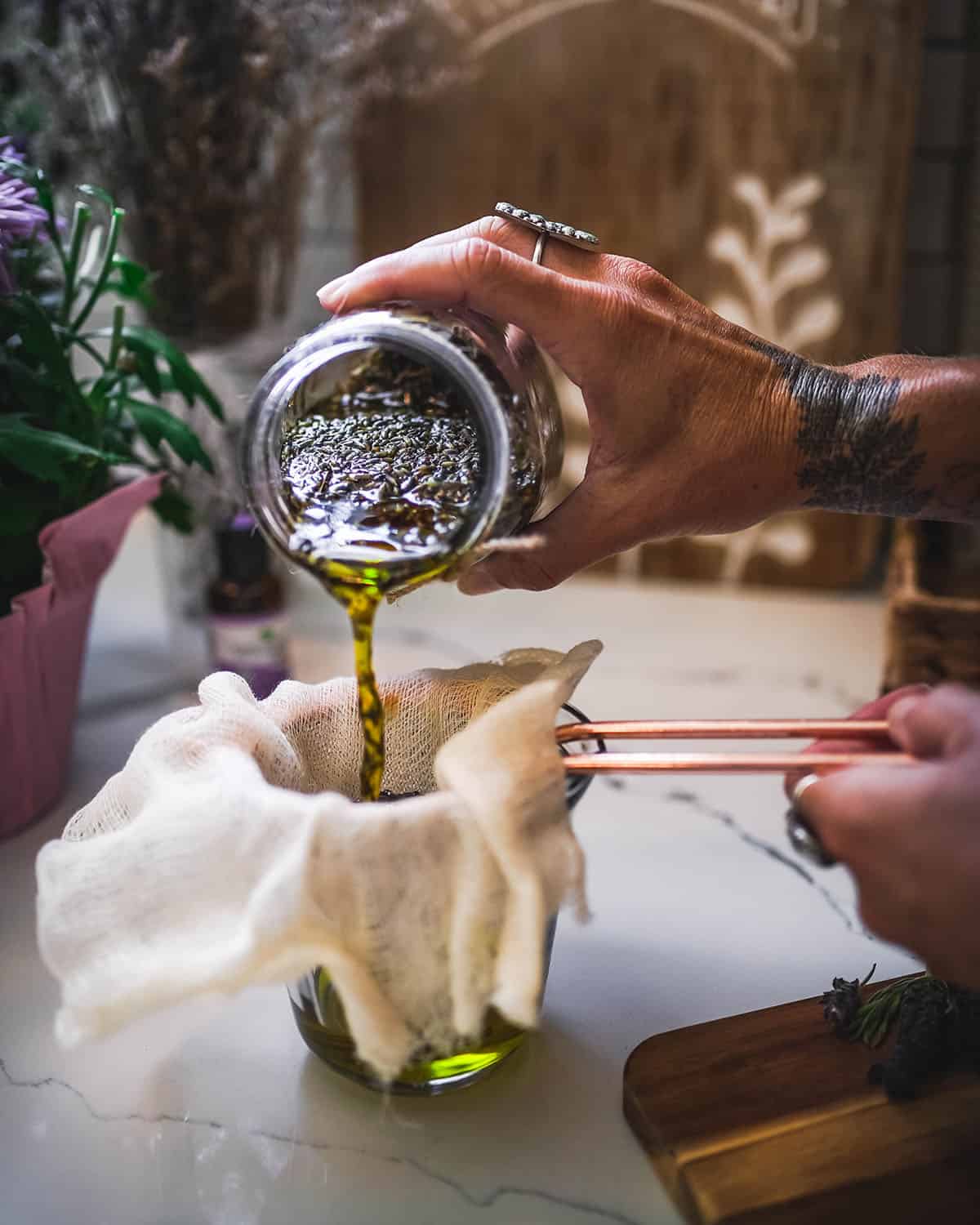
Make the Lavender Salve
Now that the oil is infused, it’s time to make this lavender salve! Use a kitchen scale to measure the beeswax and shea butter.
If you don’t have a digital scale, you can convert the suggested ½ ounces into measuring spoons. For this recipe, the equivalent would be about 3 teaspoons.
Using a double boiler, or a makeshift double boiler with a measuring cup resting inside a pot half filled with water, heat the boiler on medium heat.
Add the beeswax first since it takes the longest to melt. Once the beeswax is melted to liquid, add the shea butter.
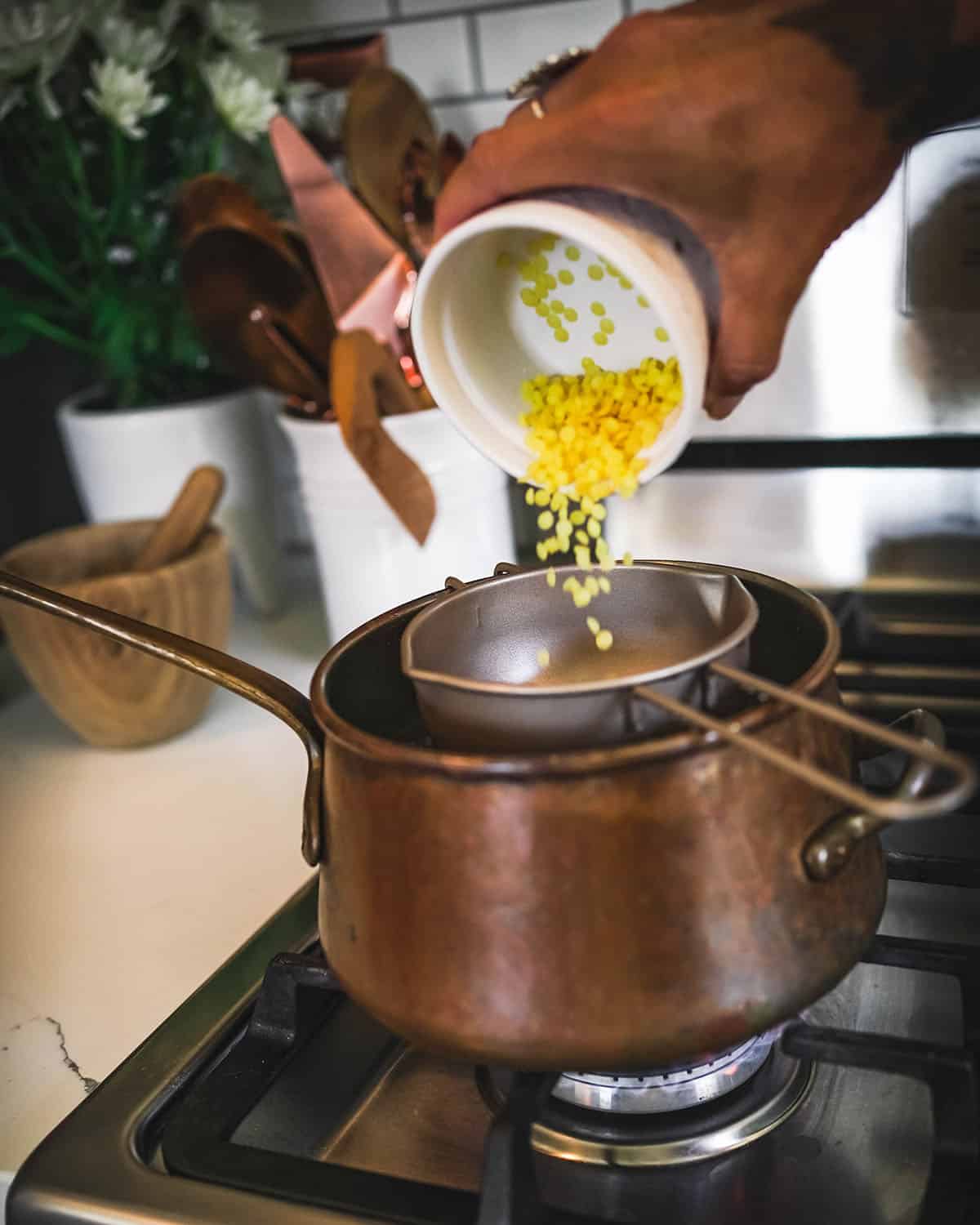
Next, add the lavender-infused oil and essential oil drops (if using) and stir together until everything is liquefied.
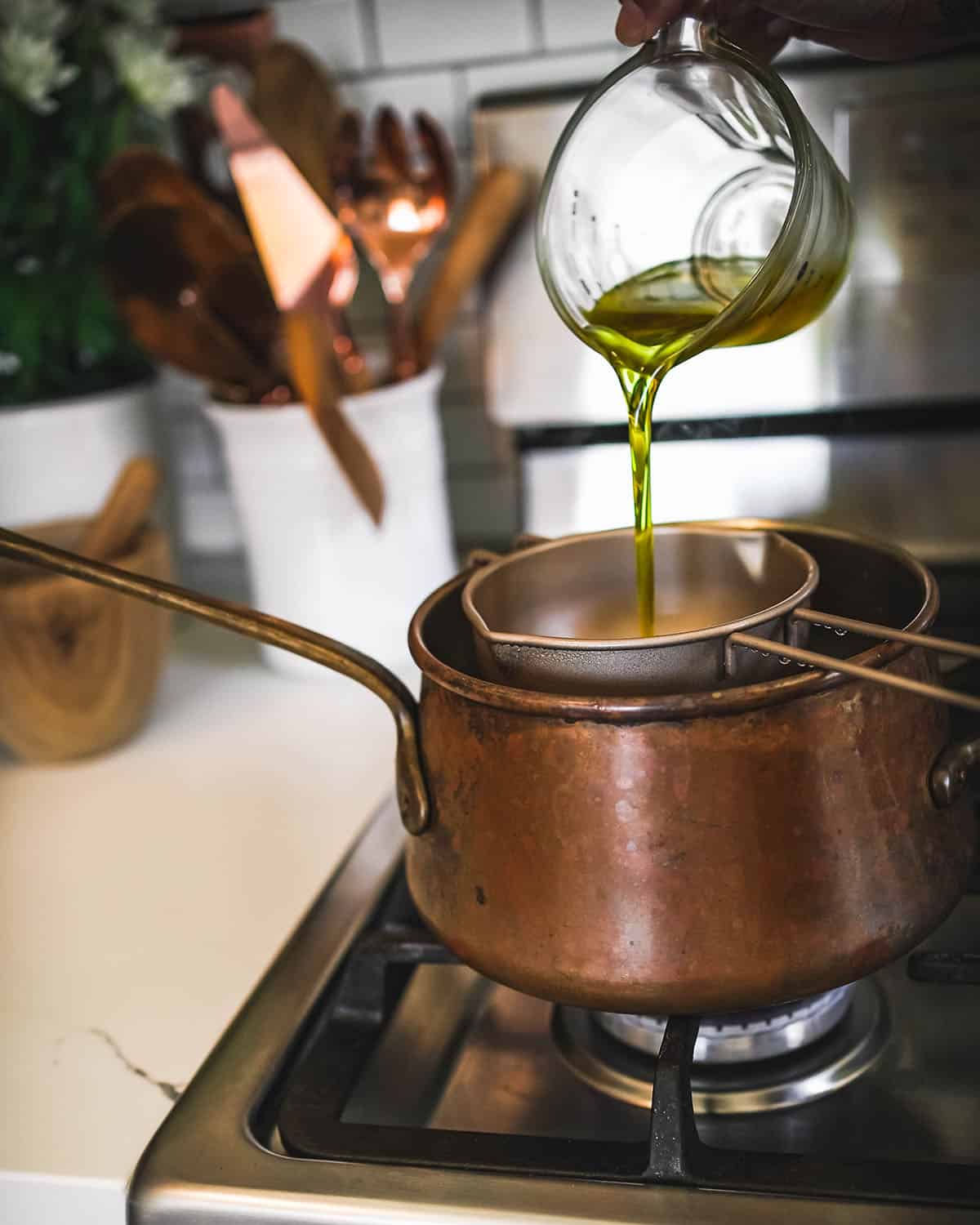
Line up the tins and carefully pour the lavender salve liquid into each one.
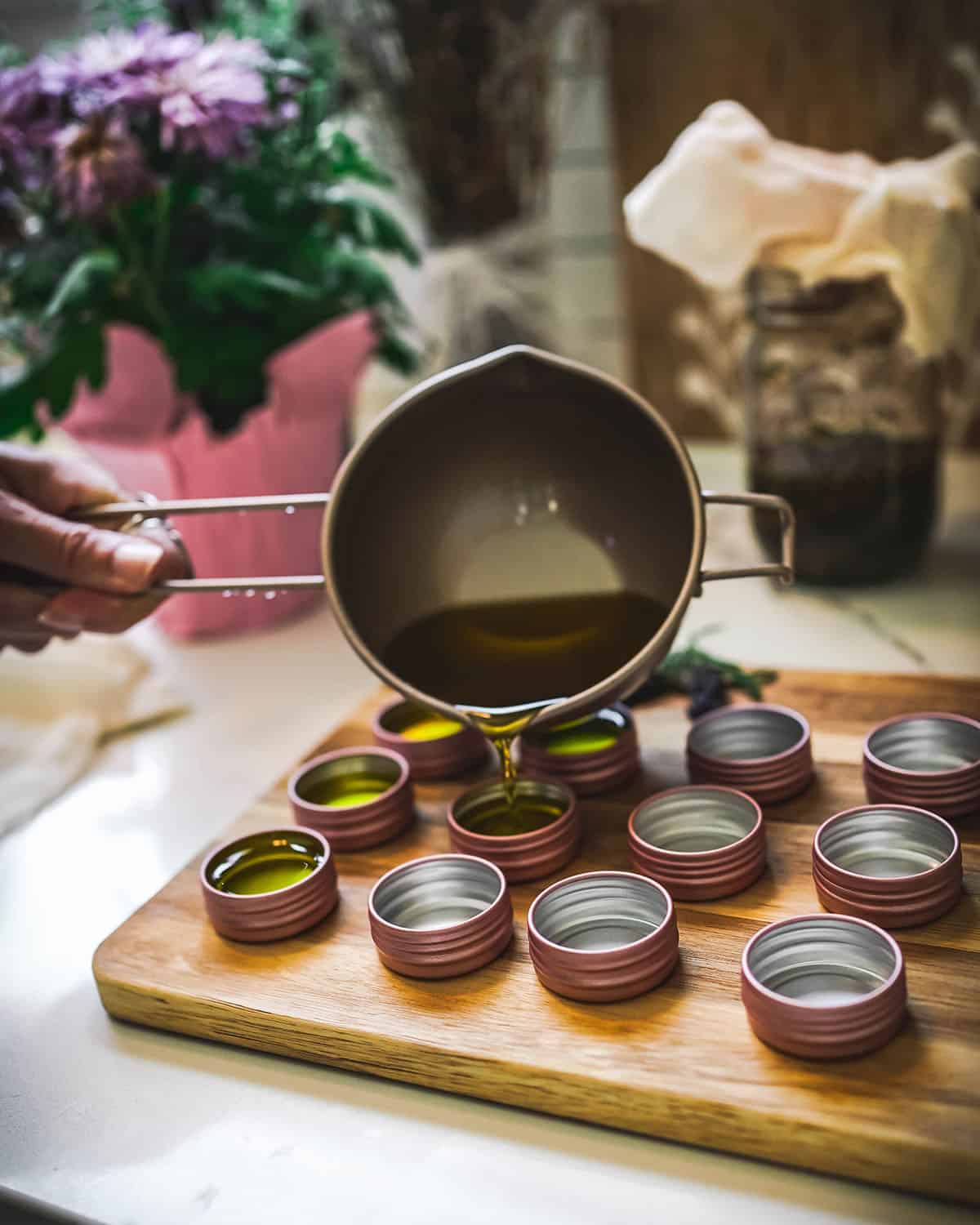
Allow the tins plenty of time to cool and solidify which usually takes a few hours.
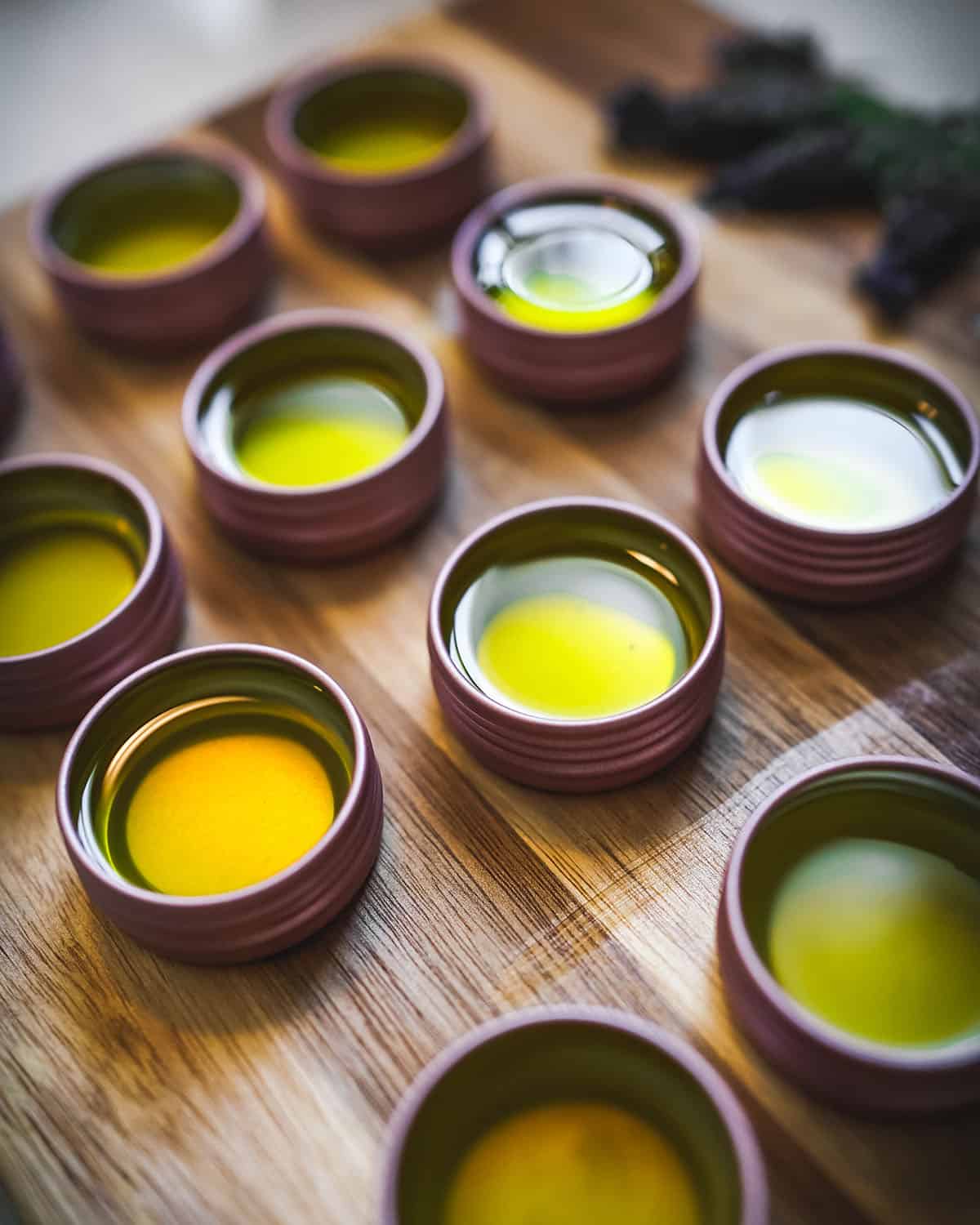
How to Use Healing Lavender Salve
This salve has a wonderfully soothing creamy consistency and an aroma that will seem to magically melt your stress away.
Use this healing salve with lavender to balance your mental state. It will also help heal any skin ailments including blemishes and dry skin areas.
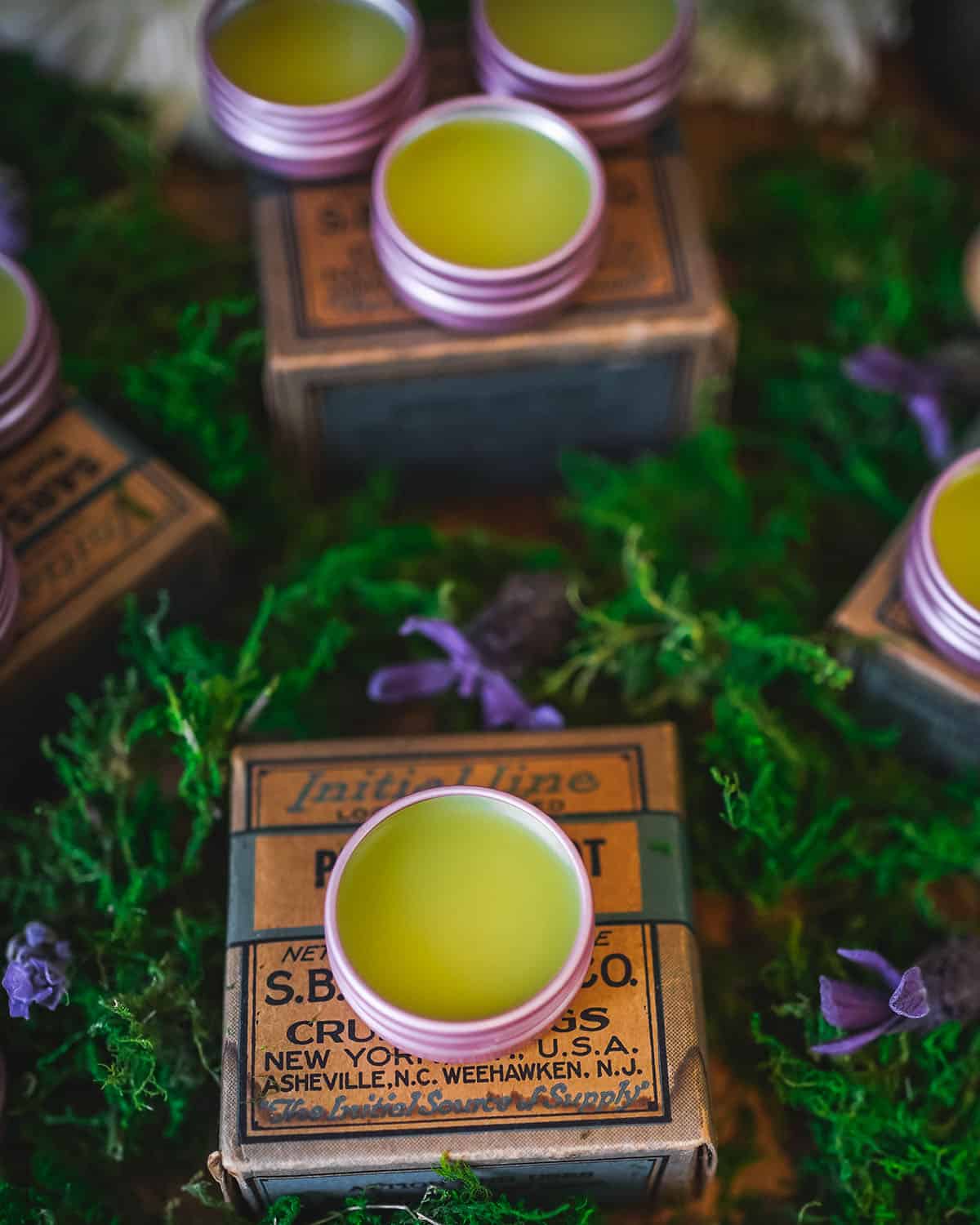
This salve will soak in, help you sleep, and help heal any wounds physically and mentally. The powers and beauty of lavender are unmatched, and this salve is a star!
Rest easy, take care of yourself, and heal!
More healing salve recipes:
- Calendula Salve
- How to Make a Yarrow Plant Salve
- Plantain Salve
- Dandelion Salve
- Comfrey Salve
- Chickweed Salve
- Herbal Salve
- 10 Herbal Salve Recipes
- Pine Salve
See all of my salve and cream recipes here!
Healing Lavender Salve
Equipment
- Double Boiler
Ingredients
Lavender Infused Oil
- 1/2 cup dried lavender flowers
- 12 ounces olive oil
- 4 ounces refined coconut oil
Lavender Salve
- ½ cup infused lavender oil
- ½ ounce beeswax
- ½ ounce refined shea butter
- 12-18 drops lavender essential oil optional
Instructions
Lavender Infused Oil
- To make the lavender-infused oil, use a 16-ounce glass mason jar and fill it with 4 ounces of lavender flower buds.
- Pour in olive oil over the lavender flowers until the jar is ¾ of the way full. Top off the remaining with ¼ of coconut oil. Cap the jar and give it a little shake.
- At this point, you can do the slow infuse method and leave it in a cool dry place for a few weeks. Or you can do the quick heated method by using a pot with water.
- For the quick heated method, simply fill a pot with water and place your lavender oil jar inside the pot. Allow your pot to simmer on low for several hours, slowly heating the jar and oil inside. Turn off the heat from the stove and allow your jar to rest in the hot water bath for the rest of the day. Carefully remove your jar to get it ready to strain.
- Once the lavender oil has infused, strain out the flowers from the oil with a fine mesh sieve lined with cheesecloth over a glass measuring cup until it reaches the 1/2 cup line.
Lavender Salve
- Next, using a kitchen scale, measure out the remaining ingredients to create the salve.
- Once the ingredients have been measured out, use a double boiler or make one by filling a pot with water ½ way and placing a glass measuring cup inside the pot.
- With the stove on medium heat, add the beeswax first. (This ingredient takes the longest to melt, so it is best to start with this one first).
- After the beeswax has melted down to a liquid, add in the shea butter.
- Lastly, add in the lavender infused oil and stir all ingredients along with the optional lavender essential oil together until they have all liquefied.
- Now line up all the tins and carefully pour the liquid into each one. Allow the tins to cool on the counter for a few hours until completely cooled and solidified.
Notes
- If you don’t have a digital scale, you can convert the suggested ½ ounces into measuring spoons. For this recipe, the equivalent would be about 3 teaspoons.
- This recipe will yield about 12 half-ounce tins, or less for bigger tins.
- This salve is creamy and ultra-moisturizing and with the addition of shea butter, the smell is absolutely wonderful! Perfect for so many skin issues and a must-have to pack on the go.

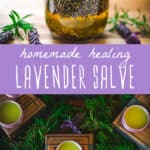
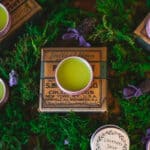

You say you can use fresh or dried lavender. If it’s fresh, how do you separate the flowers??? Or do you just dry it first? Or just cut at the base of the buds and let it infuse kinda clumped together?
Hi Jill. If using fresh, you can use the entire flower head, you don’t need to separate the flowers.
Have you ever used any oil other than coconut oil. I am alletgic to coconut oil but would love to try this recipe. If you haven’t I will experiment and let you know. How it goes. Thanks.
Yes, you can you can use whichever oils you prefer!
Do you melt the coconut oil prior to mixing it? If it is a solid, how do you keep it for several weeks to make the infused oil?
Yes, I make sure the coconut oil is liquid before adding to the jar.
Hello Colleen. Thank you for your recipe. When foraging lavender, could I also used the leaves to soak in oil? or does it have to be just the flower buds? Thank you.
Of course!
Would this be safe to use on a 2 year old?
Yup! See also my diaper rash salve.
Hello! Just wondering how long this keeps at room temp without going mouldy. I’ve made skincare stuff in the last without preservatives and it went off long before I could use it up. Don’t want to waste any ingredients, so thinking of making a 1/2 or quarter batch depending on how long it will keep.
Homemade herbal salves can last a really long time, a year or longer when stored properly out of sunlight and contain no extra moisture from the herbs.
If this is to be used mainly for help in sleeping, where do you use the salve?
You can use it on any skin that needs to be moisturized.
Thank you for this! Could I opt out of the shea and if so, should i just add a bit more beeswax?
Sure, that should still work!
I love this recipe! Tried it for myself on nights I can’t sleep and it’s a godsend. Can you tell me though where you got the double boiler piece that you use with your pot? I love that you can use it to pour right into the tins!
Hi Kim! I bought mine on Amazon here.
I wanted to check on the amount of lavender as 4 ounces was too much for the quart size jar.
Hi Lisa, it should be 1/2 cup, not 4 ounces in weight. Sorry about that!